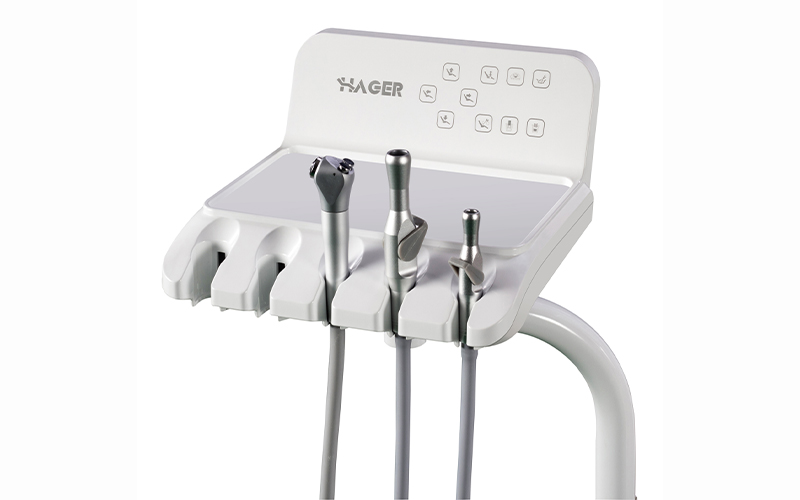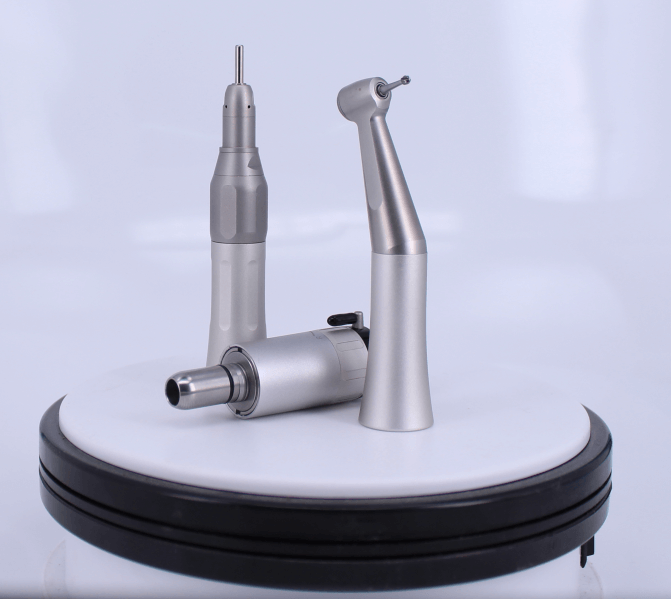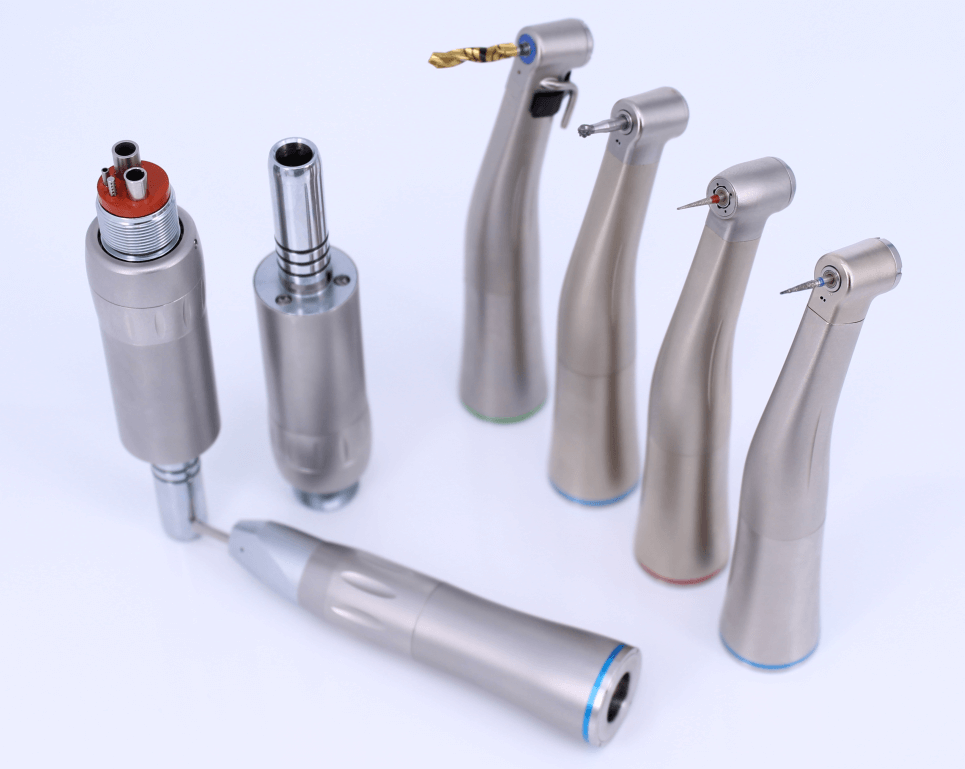Surgical Handpiece Sterilization: Step-by-Step Protocol to Prevent Cross-Contamination
At Hager Dental, we understand that proper sterilization of surgical handpieces is essential for patient safety and practice integrity. As a dental equipment manufacturer with ISO9001, EN ISO13485, and CE certifications, we've developed this comprehensive guide to help you implement effective sterilization protocols.
Scientific evidence confirms that both high-speed and low-speed handpieces can transmit pathogens between patients when improperly sterilized. Our step-by-step protocol integrates the latest AORN and CDC guidelines (updated for 2025) to help your practice maintain the highest infection control standards while extending the lifespan of your valuable equipment.
AORN vs CDC Guidelines: Navigating Sterilization Standards in 2025
The landscape of sterilization guidelines continues to evolve, with both the Association of Perioperative Registered Nurses (AORN) and the Centers for Disease Control and Prevention (CDC) providing crucial frameworks for dental professionals. Understanding the nuances between these guidelines is essential for comprehensive compliance.

Key Differences in Current Recommendations
The AORN has recently updated its Guideline for Sterilization, with the print version released in early 2025. These updates address evolving sterilization methods, new technologies, and best practices to ensure patient safety and compliance with FDA-cleared processes. The revised guidelines emphasize:
- Pre-purchase evaluation of medical devices to ensure compatibility with existing sterilization equipment
- Resolution of conflicting instructions for use (IFU) between sterilization equipment, packaging, and medical device manufacturers
- Sterilization protocols for 3D-printed medical devices and experimental onsite-manufactured devices
- Physical separation of decontamination and clean work areas with a minimum four-foot separation where a two-room configuration isn't possible
In contrast, the CDC guidelines maintain their focus on the fundamental principle that all dental handpieces and their attachments "should always be heat sterilized after each patient". The CDC explicitly states that surface disinfection, submersion in liquid chemical sterilants, or barrier protection are inadequate methods for cleaning, disinfecting, or sterilizing internal components.
Implementing Compliant Protocols
To implement a sterilization protocol that satisfies both AORN and CDC guidelines, we recommend:
- Conducting a gap analysis of your current sterilization practices against the latest guidelines
- Reviewing manufacturer's IFUs for all handpieces and sterilization equipment
- Resolving any conflicts between different manufacturers' instructions by contacting them directly for clarification
- Documenting your protocol to ensure consistency and compliance across all staff members
The CDC explicitly recommends that dental health care personnel (DHCP) use only FDA-cleared devices and reprocess instruments between each patient according to the manufacturer's instructions. If a dental handpiece cannot be heat sterilized and does not have FDA clearance with validated instructions for reprocessing, the CDC advises that DHCP should not use that device.
Autoclave Cycle Parameters: Precision Settings for Optimal Sterilization
Achieving effective sterilization requires precise autoclave settings that balance microbial elimination with equipment preservation. Our engineering team at Hager Dental has developed handpieces specifically designed to withstand proper sterilization cycles without compromising performance.

Temperature Requirements for Complete Sterilization
The recommended temperature range for dental autoclave sterilization typically falls between 121°C to 134°C (250°F to 273°F). For most Hager handpieces, we recommend sterilization at 134°C (273.2°F) for optimal results.
This temperature setting has been validated to effectively eliminate all microorganisms, including highly resistant bacterial spores, while maintaining the structural integrity of our precision-engineered components. It's important to note that sterilization and drying temperatures must never exceed 135°C, as higher temperatures can damage internal components and compromise handpiece functionality.
Cycle Duration and Pressure Considerations
Effective sterilization depends on three critical factors working in concert:
- Temperature: As noted above, 134°C is optimal for most dental handpieces
- Pressure: Typically 30-31 psi (2.1-2.2 bar) at 134°C
- Time: A minimum of 5 minutes at the target temperature
For Hager handpieces, we recommend the following autoclave cycle parameters:
| Parameter | Recommended Setting |
|---|---|
| Temperature | 134°C (273.2°F) |
| Pressure | 30-31 psi (2.1-2.2 bar) |
| Minimum Sterilization Time | 5 minutes |
| Minimum Drying Time | 10 minutes |
These parameters have been validated through extensive testing to ensure complete sterilization while preserving the precision components in our handpieces. It's crucial to note that instruments are extremely hot immediately after autoclaving and should not be handled until they have cooled.
Bearing Lubrication Techniques: Extending Handpiece Lifespan
Proper lubrication is perhaps the single most important maintenance procedure for extending the operational lifespan of dental handpieces. Our precision bearings at Hager Dental require specific lubrication protocols to maintain optimal performance.

Understanding Lubrication Types
Two primary lubrication methods exist for dental handpieces:
- Grease lubrication: Forms a semi-solid protective film that enhances adhesion to moving parts, preventing metal-to-metal contact and reducing friction
- Oil lubrication: Utilizes mineral or synthetic oils to ensure smooth operation
For our high-performance handpieces at Hager Dental, we recommend synthetic formulations due to their superior thermal stability, oxidation resistance, and wider temperature operating range. These advanced lubricants maintain their protective properties even under the high temperatures experienced during autoclave sterilization.
Step-by-Step Lubrication Protocol
For optimal handpiece performance and longevity, follow this systematic lubrication protocol:
- Remove the bur from the handpiece
- Clean the exterior of the handpiece under running water
- Important: Never immerse handpieces in disinfectant or any chemical solution, including water, as this can damage internal components
- Separate head and shank as appropriate for your specific handpiece model
- Apply lubricant with the appropriate nozzle, continuing until clean lubricant appears from the chuck
- Always shake the lubricant can prior to use and keep it upright during application
- Use tissue to remove excess lubricant before proceeding to sterilization
- After sterilization and cooling, run the handpiece briefly before use to clear any remaining lubricant
Consistent application of this lubrication protocol between each patient use will significantly extend the operational lifespan of your handpieces while ensuring optimal performance during clinical procedures.
Bur Removal Torque Specifications: Protecting Critical Components
Understanding and adhering to proper torque specifications during bur removal and installation is essential for preventing damage to handpiece components. Our engineering team at Hager Dental has carefully calibrated optimal torque values for each handpiece model.
Torque Variations by Handpiece Type
High-speed and low-speed handpieces operate with fundamentally different torque characteristics:
- High-speed handpieces: Typically operate at 250,000+ RPM with relatively low torque
- Low-speed handpieces: Function at 5,000-40,000 RPM with significantly higher torque delivery
These differences necessitate distinct approaches to bur handling. For high-speed handpieces, we recommend using the push-button system with minimal force to prevent damage to the delicate chuck mechanism. When performing the chuck grip test:
- Take care to insert the tester straight all the way in
- Hold down the push button firmly
- Push the tester all the way in, then release the push button
- Pull the tester slowly until you see a groove
For low-speed handpieces, follow the specific removal instructions provided with your Hager model, as the mechanism may vary depending on the specific design.
Impact on Handpiece Longevity
Research has demonstrated that proper torque management significantly affects handpiece performance and longevity. Excessive force during bur insertion or removal can damage the chuck mechanism, leading to premature failure and costly repairs.
At Hager Dental, we design our handpieces with precision chuck systems that maintain optimal torque specifications throughout their operational lifespan. This engineering approach helps preserve component integrity while ensuring consistent performance during clinical procedures.
Staff Competency Assessments: Ensuring Protocol Compliance
Implementing comprehensive staff competency assessments is a critical component of effective sterilization programs. The AORN's updated guidelines emphasize the importance of staff education and competency verification in maintaining sterilization standards.
Key Assessment Components
Effective competency assessment tools should evaluate both knowledge and practical skills of staff working in reprocessing areas. We recommend including the following components in your assessment protocol:
- Standard precautions: Appropriate PPE usage, hand hygiene requirements, and understanding of contamination zones
- Instrument sorting: Safe transport of contaminated instruments, proper disassembly of complex equipment, and identification of items requiring special care
- Chemical handling: Correct dilutions, safety protocols, and appropriate application methods
- Sterilization parameters: Understanding of temperature, pressure, and time requirements for different instrument types
- Documentation procedures: Proper recording of sterilization cycles, maintenance activities, and quality control tests
Regular competency assessments help identify knowledge gaps and training needs before they result in sterilization failures or regulatory non-compliance.
Documentation and Compliance Verification
Proper documentation of competency assessments provides essential verification for regulatory compliance. Each staff member should demonstrate proficiency in all aspects of the sterilization protocol, including:
- Manual cleaning protocols: Correct water temperatures and removal procedures for gross soil
- Lubrication techniques: Proper application methods and product selection
- Sterilization packaging: Appropriate materials and sealing methods
- Autoclave operation: Correct cycle selection and parameter verification
- Quality control procedures: Proper use of physical, chemical, and biological indicators
Maintaining comprehensive records of these assessments not only satisfies regulatory requirements but also provides valuable data for continuous quality improvement initiatives.
Integrating Sterilization into Your Practice Workflow
Effective sterilization requires seamless integration into your practice's daily workflows. The updated AORN guidelines provide enhanced direction for ensuring sterility during transport, including considerations for environmental controls and proper handling techniques.
Workflow Optimization Strategies
To optimize your sterilization workflow, consider implementing the following strategies:
- Designated sterilization areas: Create clearly defined zones for contaminated, processing, and sterile storage
- Visual workflow indicators: Use color-coding or signage to prevent cross-contamination between zones
- Standardized protocols: Develop step-by-step procedures for each phase of the sterilization process
- Adequate instrument inventory: Maintain sufficient quantities to accommodate sterilization cycle times
- Regular maintenance schedules: Establish preventive maintenance routines for all sterilization equipment
These strategies help minimize bottlenecks while ensuring consistent adherence to sterilization protocols.
Compliance with 2025 Regulatory Standards
The regulatory landscape continues to evolve, with increased emphasis on documentation and validation of sterilization processes. The CDC's guidelines emphasize that "DHCP should use FDA-cleared devices and reprocess instruments between each patient according to the manufacturer's instructions for use".
To ensure compliance with current standards, maintain comprehensive records of:
- Sterilization cycles: Date, time, parameters, and operator
- Maintenance activities: Lubrication, calibration, and repairs
- Quality control tests: Physical, chemical, and biological indicators
- Staff training: Initial education and ongoing competency assessments
These records provide essential documentation for regulatory inspections and quality assurance reviews.
Commitment to Excellence in Sterilization
Proper handpiece sterilization requires precision, consistency, and adherence to validated protocols. At Hager Dental, we design our equipment with sterilization compatibility as a core engineering principle, reflecting our commitment to both regulatory compliance and patient safety.
The evolving landscape of sterilization guidelines demands continuous adaptation. By implementing the protocols outlined in this guide, your practice can confidently meet current standards while preparing for future regulatory developments.
For additional information about our sterilization-compatible dental equipment or personalized protocol recommendations, visit Hager Dental or contact our technical support team.
Remember: Effective sterilization protects your patients, staff, and practice reputation. Invest in proper protocols today to ensure safer outcomes tomorrow.

